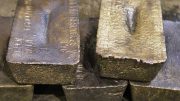Looking for an excuse to celebrate something in mining? Look no further than the one-hundredth anniversary of the invention of stainless steel — that wonderfully shiny, hard, corrosion-resistant alloy that’s one building block of a modern industrial society, and the impetus behind the development of the Sudbury nickel-mining camp.
It’s actually a little difficult to pin down the exact year of stainless steel’s invention and the exact man behind it, but the industrysupported, Brussels-based Nickel Institute has pegged it as 1912, and is holding events globally this year to mark the centenary. (In contrast, the Stainless Steel Information Center in the U.S. pins it down to somewhere between 1910 and 1915.)
The scientific groundwork for stainless steel was laid down in the 1820s by James Stoddard and Michael Faraday in England and Pierre Berthier in France, among others, who found that iron-chromium alloys were more resistant to chemical attack than ordinary steel.
However, they only worked with low-chromium alloys and didn’t grasp the critical importance of a low carbon content in the alloy.
According to the British Stainless Steel Association, the next big figures were Englishmen Woods and Clark, who patented a corrosion-resistant iron alloy in 1872 containing 30% to 35% chromium, and 2% tungsten. Three years later Frenchman Brustlein underscored the necessity of keeping the carbon content of the iron alloy below 0.15%.
Two decades passed before Germany’s Hans Goldschmidt provided the next breakthrough: an aluminothermic reduction process that produces carbon-free chromium.
In 1904 Frenchman Leon Guillet carried out extensive research on many iron-chromium alloys, and then went on to study ironnickel- chromium alloys, getting ever closer to today’s standard varieties of stainless steel.
Another pivotal year was 1911, when Germans P. Monnartz and W. Borchers found that chromium levels in an iron alloy need to be at least 10.5% to achieve high-quality corrosion resistance.
It’s at this moment, in 1912, that perhaps the most deserving claimant to the title “father of stainless steel” entered the scene: Sheffield-born Englishman Harry Brearley. He had been given the task by a small-arms manufacturer to develop an erosion-resistant — not corrosion-resistant — steel for use in a gun barrel, and he began experimenting with steel having chromium contents ranging between 5% and 15%.
On August 13, 1913, in Sheffield, Brearley came up with his perfect recipe: a steel with 12.8% chromium and 0.24% carbon, which is arguably the first-ever stainless steel. The product proved to be remarkably resistant to chemical attack by agents such as nitric acid, vinegar and lemon juice.
Brearley immediately grasped the commercial importance of his discovery to the local cutlery industry, and named his discovery “rustless steel.” Brearley turned to local cutler R.F. Mosley, who quickly perfected the hardening process, and dubbed the product “stainless steel.” The name stuck.
Germany’s Krupp Iron Works also has a strong claim to be the inventor of stainless steel, having produced a chrome-nickel steel hull for the Germania yacht — later renamed The Half Moon — in 1908, though it’s not clear whether the 10.5% chromium level was achieved. The yacht is sunk off Florida’s east coast, if anyone wants to check.
Furthermore, in 1912, while working for Krupp, Edward Maurer and Benno Strauss were granted patents on two chromium-nickel iron alloys. It’s this event that the Nickel Institute is marking as the first appearance of stainless steel.
Other claimants to the “father of stainless steel” title include Elwood Haynes and other scientists in the U.S., Max Mauermann of Poland and gun barrel manufacturers in Sweden.
The matter will likely never be settled.
• The Bank of Nova Scotia has struck a deal to sell its iconic graniteclad, Scotia Plaza headquarters in the heart of Toronto’s financial district for a cool $1.2 billion — the highest price ever paid for a building in Canada. The buyers are Dundee Real Estate Investment Trust (66.6%) and H&R Real Estate Investment Trust (33%). The 68-floor tower, completed in 1988, boasts 2 million sq. ft of floor area and a 99.5% occupancy rate, with Scotiabank occupying 61% of the space.
Scotiabank had been the last of the big six banks in Canada to still own its headquarters, and the company had been looking to bulk up its cash reserves in the face of tighter global banking regulations.
Send your Letters-to-the-Editor and op-ed submissions to the Editor-in-Chief at: tnm@northernminer.com, fax: (416) 510-5138, or 80 Valleybrook Dr., Toronto, ON M3B 2S9.


Be the first to comment on "Editorial: Stainless steel turns 100"